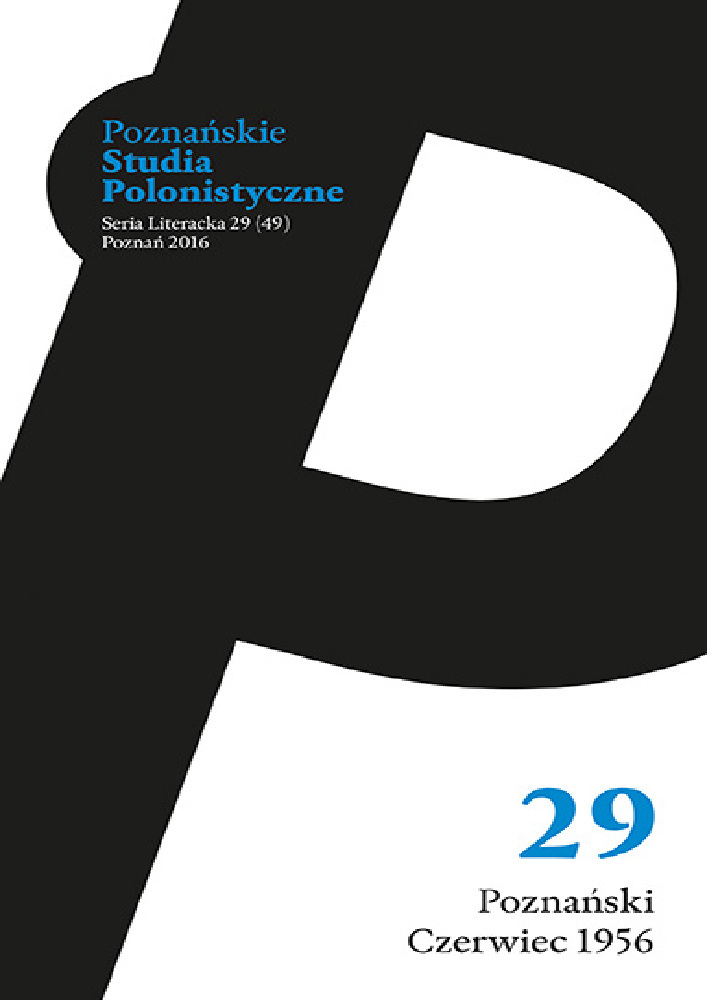Abstrakt
The purpose of this paper is to demonstrate three possible methods of reading and interpreting three consequent literary works on the Hungarian Revolution of 1956 that describe the events from a perspective of an adolescent boy. The mentioned works are the following: The Radiance of Childhood (Gyermekkor tündoklete) by Istvan Kovacs, Hungarian Revolution 1956: Diary (Magyar Forradalom 1956. Naplo) by Gyula Csics and Kalef by Zsolt Berta. The first demonstrated approach provides a documentary-like look on the October 1956 that is given by dint of (auto)biographical elements or diaristic form. The second method ensures much closer analysis of the Hungarian history across time (before, during and after the Revolution) and space (Hungarian country and Budapest). The third approach targets the aspects of initiation into adulthood, masculinity and Hungarian history of the 20th century that allows to read the three stories as a novels of initiation.
Bibliografia
Alexa Károly (1998), „Emlékezetre méltó dolgok”, „Kortárs”, nr 9, s. 95-100.
Berta Zsolt (2016), Chłopcy z placu Moskwy, przeł. Daniel Warmuz, „Akcent”, nr 4, s. 11-16.
Berta Zsolt (2014), Kalef, Magyar Napló, Budapest.
Csics Gyula (2016), Węgierska rewolucja 1956. Pamiętnik dwunastolatka, przeł. Anna Butrym, wstęp Łukasz Kamiński, Wydawnictwo IPN, Warszawa.
Czapliński Przemysław (1997), Ślady przełomu. O prozie polskiej 1976-1996, Wydawnictwo Literackie, Kraków.
Gennep Arnold van (2006), Obrzędy przejścia, przeł. Beata Biały, red., wstęp Joanna Tokarska-Bakir, PIW, Warszawa.
Głowiński Michał (2006), O konieczności nie-bycia sobą, „Teksty Drugie”, nr 1-2, s. 320-325.
Hadaczek Bolesław (1982), Bohater rozwojowy, w: Postać w dziele literackim, red. Czesław Niedzielski, Jerzy Speina, Uniwersytet Mikołaja Kopernika, Toruń.
Kovács István (2002), Lustro dzieciństwa, przeł. Anna Górecka, Czytelnik, Warszawa.
Łubczyk Grzegorz, Maldis Marek (2006), 13 lat 13 minut, Oficyna Wydawnicza RYTM, Warszawa.
Nagy Dániel (2015), Szabadság, szerelem, rock and roll – és egy generáció elveszett illúziói, „Hitel”, nr 7, s. 126-128.
Orbán Katalin (2012), „D.e.: Olvastam a Sándor Mátyást. Később a rádiót hallgattam”: az ‚56-os gyereknaplók médiumai, w: Kultpontok: Emlékezethelyek a magyar populáris kultúrában, red. Tamás Dunai, Szabolcs Oláh, Attila Sebestyén, Debreceni Egyetemi Kiadó, Debrecen.
Pomogáts Béla (2002), „Mikor a rózsák nyílni kezdtek”. 1956 az irodalom emlékezetében, „Forrás”, nr 4, s. 92-104.
Standeisky Éva (2006), Irodalom a forradalomban, The Institute for the History of the 1956 Hungarian Revolution [online], [dostęp: 3 września 2016] http://server2001.rev.hu/msite/index.asp?id=4.
Stumpf András (2015), „Luk van” – Berta Zsolt ‚56 örökségéről, a Kalefről és az életről a Mandinernek, Mandiner [online], [dostęp: 3 września 2016] http://mandiner.hu/cikk/20151022_berta_zsolt_interju_kalef_1956_luk_van.
Szakolcsay Lajos (2000), Kovács István: „A gyermekkor tündöklete”, „Tiszatáj”, nr 2, s. 92-95.
Licencja
Autorzy
Autorzy tekstów przyjętych do publikacji w czasopiśmie „Poznańskie Studia Polonistyczne. Seria Literacka” są zobowiązani do wypełnienia, podpisania i odesłania na adres redakcji umowy o udzielenie nieodpłatnej licencji do utworów, z zobowiązaniem do udzielania sublicencji CC.
Zgodnie z umową, autorzy tekstów opublikowanych w czasopiśmie „Poznańskie Studia Polonistyczne. Seria Literacka” udzielają Uniwersytetowi im. Adama Mickiewicza w Poznaniu niewyłącznej i nieodpłatnej licencji oraz zezwalają na użycie sublicencji Creative Commons Attribution-NoDerivatives 4.0 International (CC BY-ND 4.0).
Autorzy zachowują prawa do dalszego, swobodnego rozporządzania utworem.
Użytkownicy
Zainteresowani użytkownicy internetu uprawnieni są do korzystania z utworów opublikowanych od 2016 roku w „Poznańskich Studiach Polonistycznych. Serii Literackiej” pod następującymi warunkami:
- uznanie autorstwa – obowiązek podania wraz z rozpowszechnionym utworem, informacji, o autorstwie, tytule, źródle (odnośniki do oryginalnego utworu, DOI) oraz samej licencji;
- bez tworzenia utworów zależnych – utwór musi być zachowany w oryginalnej postaci, nie można bez zgody twórcy rozpowszechniać np. tłumaczeń, opracowań.
Do wszystkich tekstów opublikowanych przed 2016 r. prawa autorskie są zastrzeżone.
Inne
Uniwersytet im. Adama Mickiewicza w Poznaniu zachowuje prawo do czasopisma jako całości (układ, forma graficzna, tytuł, projekt okładki, logo itp.).
